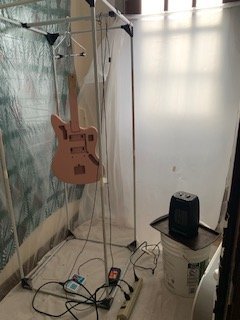fishbonetabby
Newbie
- Messages
- 16
First of all, the build quality on the neck I got from Warmoth is absolutely stunning. I’m going to start the finishing process tomorrow. One thing I’m really unsure about is the neck heel. I was planning on masking the neck heel where it screws into the body until the last final coats of clear nitro where I’ll cover it lightly just to protect the wood.
I’ll be filling the grain with Z poxy and finishing the neck with clear nitro. I’m anticipating at least 2-3 coats of grain filler before I start building the nitro. Is there any benefit to putting down a coat of vinyl sealer between the z poxy and nitro? I’d love to hear how others would approach finishing this neck.
I’ll be filling the grain with Z poxy and finishing the neck with clear nitro. I’m anticipating at least 2-3 coats of grain filler before I start building the nitro. Is there any benefit to putting down a coat of vinyl sealer between the z poxy and nitro? I’d love to hear how others would approach finishing this neck.



